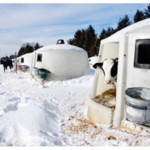Click here to view as a pdf: Swift Start Calf Feeding Trial Update
By Teresa Marker, B.S.
The goal of any dairy calf raiser is to have a healthy, productive, replacement heifer that is a profitable addition to their milking line. The Crystal Creek® Swift Start® Calf & Heifer program consists of a line of milk replacers, texturized calf feeds, calf pellets and mineral formulated with industry-leading technology and manufactured with the highest quality ingredients available. University research has proven time and time again that the way calves are fed and raised during the pre-wean period will affect their performance later in life. In the “Swift Start® Calf Feeding Challenge” newsletter article published in April of 2017, Crystal Creek® provided documentation of superior performance results in pre-weaned calves that were on the Swift Start® Calf & Heifer program. This data showed higher body weight gains, improved feed conversion rates, improved nutrient digestibility, less veterinary intervention and smoother transitions into weaning. The calves on the Swift Start® calf feeding program not only outperformed the calves on the competitor’s program but also saved the calf raiser money. This article will take topics highlighted in the initial trial a step further and evaluate the performance of heifer calves as they transition into post-weaned heifers and ultimately, progress into the lactating herd.
Read More →





